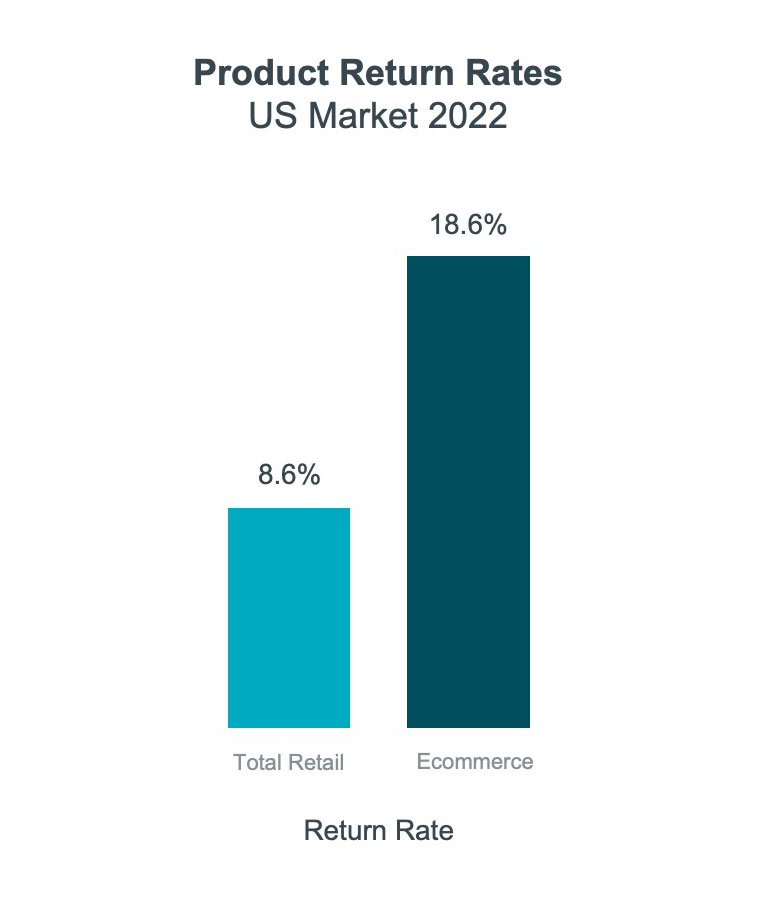Enhancing product information management through automation and analytics can provide better customer experiences and improve decision making
Automated product onboarding and data enrichment, analyzing information completeness and validating data through governance workflows are actions ecommerce retailers can take to proactively reduce the amount of returns instead of ramping up returns management.
Returns have been a pervasive problem for ecommerce retailers since online shopping began, and it’s only going to become more challenging with the continued growth in online sales. Over the past several years most consumers have increasingly adopted digital shopping activities and now rely more on ecommerce to meet their shopping needs. When evaluating products online consumers are constrained to small product pictures on a mobile phone or inadequate product descriptions it becomes quite easy to make the wrong choice. Apparel products are particularly impacted because product sizing is hard to communicate effectively online as each brand and type of clothing can fit differently, so the return rate is noticeably higher online vs. in store.
Ecommerce return rate is 2 to 3 times of that of brick and mortar

Source: eMarketer, November 2022
With all of these challenges with ecommerce and inefficiency, retailers may be wondering how to more forcefully incentivize consumers to shop in store. Retailers have worked on mitigating the post purchase activities such as allowing for return to store or easy labels to print to ship them from the post office. But aren’t there more strategies that can be enacted before the purchase in the discovery and shopping phase of the shopper journey?
The question for retailers is: What can you proactively do to reduce the amount of returns instead of ramping up to deal with them when they come?
Ecommerce returns are not just a holiday issue or due to bad choices gift giving. So, attacking the root cause of returns – bad product information – not only puts you in a better position for enhancing the customer experience and it also prepares you for what seems to be a firm shift towards increased online shopping.

Returns are integral to ecommerce. But don’t despair.
Size of the problem:
- Returns make up a trillion-dollar problem globally (IHL: Retail Returns, April 2020)
- Online returns are about 25-30% of all ecommerce sales, whereas physical store returns are 8-10% (Forbes: Online Merchandise Returns to Hit $57 Billion for Holiday, October 2020)
Importance of getting it right to the consumer:
- 84% of online consumers would leave a retailer after a bad return experience (Klarna: Retailers risk losing loyal customers if they get returns wrong, Klarna warns, May 2021)
- 45% of consumers cite poor fit is the top reason for returns (Narvar: State of Returns: The End of One-Size-Fits-All Returns, 2022)
These staggering numbers indicate that there’s a great untapped potential for revenue growth and increased customer loyalty or those retailers who succeed in effectively managing returns, improving the experience and reducing need to return.
Returns not only cause a large revenue impact overall, they can also have a tremendous impact on margins due to lost product sales and added labor and shipping costs of managing all the volume. Per IHL’s report, The Coming Retail Returns Tsunami, returns cost retailers between 5 to 6 points of gross margin.
But instead of only ramping up returns management to handle the problem after the fact, the positive message to take away is that with the right plan and accurate data, you can prioritize proactive actions to address this challenge and reduce the overall impact of returns.
Reduce returns with better product information
It is true that online shoppers behave differently in many ways. Many use their own living room as fitting room, meaning they order several colors and sizes and then return whatever doesn’t fit. That customer behavior is probably not going away anytime soon, especially since competition amongst a variety of online retailers has popularized free returns policies.
However, preventive measures are possible for those returns that are caused by incorrect, inadequate or misunderstood product information.
According to Experian (“Control issues” see businesses struggling to realise data’s full potential), 95% of organizations have data quality problems that affect customer experience, business efficiency and reputation. This problem can be solved with an increased focus on data management, process improvement and data optimization.
 Questionable data equals bad customer experiences
Questionable data equals bad customer experiences
Data associated with products today is critical to their success. But it can lose more than 15% of its accuracy and value as it gets shared and updated. Even worse, decisions made using that data can be even more off-base. Watch the video to learn more about how bad product data is bad for business.
Product information has a huge impact on the customer experience, which in turn has a huge impact on sales and the amount of returns. Improving your product experience management with better product data becomes a strong lever to improve the customer experience. It is not enough to fulfill minimum product requirements. Make sure that your product information meets your customers’ expectations – and wows them.
Concepts to consider:
- Data completeness is the baseline: A technology product with incomplete specifications is a tough sell.
- Searchability: If customers can’t find the right product, they might check out with the second best and then return it.
- Localized content: Don’t forget to translate the user manual, too, not just the sales copy.
- Contextualized content: Build a product experience with rich content to make it appear as palpable as possible.
- Transparency: Providing insight into production methods, origin and supply chain can help build consumer trust.
Get the white paper
Building a More Sustainable Future for Retail.
How data management is integral to achieving retail sustainability goals
Below are four tips to decrease the likelihood that consumers are dissatisfied with their purchase and decide to return the merchandise.
1. Improve product data quality and completeness from your suppliers
Retailers depend on the provision of accurate and rich information, including specifications, images and user manuals, from manufacturers and distributors to be able to support end-customers in their decision making and provide a trusted online shopping experience. Retailers can make great strides in accuracy and completeness of information by having strong data cooperation from suppliers at the beginning and sourcing high-quality data deeper into the supply chain.
Automated product onboarding can help:
A product information management (PIM) system with an onboarding portal or a product data syndication portal is the crucial link between manufacturers and retailers to ensure completeness and quality of your product data. With the right integrations it is easy to feed your ecommerce platform with trusted data from suppliers, data pools and content service providers. A capable tool can help transform data automatically to remove the obstacle of exchanging data across different data models.
2. Use AI/ML to automate classification and data enrichment processes
To further enhance customer experiences with better product data, retailers can use AI to automate data enrichment and product classification processes. AI with machine learning can help validate and classify items into the right categories and segments to ensure that your product listings are placed correctly in your hierarchy. Additionally, AI/ML can meta-tag your product images in your digital asset management (DAM) system much faster than humans. Image meta tagging is another way to increase the accuracy and completeness of your data. Having good image metadata facilitates image categorization and makes images searchable in internal systems, as well as in internet search engines.
Automated data enrichment provides higher quality of data but also helps take the workload off the data management teams and provide an opportunity to work on other more value-added projects, such as creating instruction videos and writing useful responses to user reviews. It all adds up to a better customer experience and fewer product returns.
Master data management is critical to AI:
However, AI cannot stand alone. It needs master data management (MDM) as a supporting framework. The AI application needs to know which identifiers to harvest from the supplier source. Which data is important in a business context? Which data can provide the best customer experience and help reduce product returns? These identifiers and rules are built into the MDM system. The power of MDM is to bring order, logic and accessibility into data management. The combination of MDM and AI is a mutual enhancement: AI provides speed, and the data governance inherent in MDM ensures that AI delivers useful outcomes and supports business goals.
3. Evaluate product information completeness and manage minimum complete levels
With tens of thousands if not over a million products in the extended assortment, online retailers need to be able to review their product information in an analytical way. It’s important to look above the minutiae to really gain a perspective of completeness across vendors, categories and different views of data. By establishing rules for minimal attribute completeness, it is easier to compare metrics vs. baseline at different levels of the data hierarchy in order to prioritize further enrichment tasks.
Embedded analytics can help leverage product information:
Enhancing your MDM solution with embedded analytics can enable users to make data actionable, respond quickly to market trends and improve collaboration through fast, unique insights. This allows retailers to analyze and blend master data with other data sources to achieve deeper insights into business operations. For best results, merge and blend data across domains and/or from sales, inventory, click streams, IoT and social media.
4. Build robust workflows and approval process to validate data and reduce risk
Retailers who succeeded in managing their product data, have data governance in place to ensure that processes are streamlined and consistent across the organization. Additionally, automatic data quality checks as well as pre-defined approval checkpoints can be assigned to ensure that data has final review before it is published to website and other sales channels.
Master data management provides data governance:
One of the core strengths of master data management is its data governance capabilities to safeguard all product information parameters, including securing the quality of information before it gets published. MDM facilitates data modeling, description of data processes, adherence to data standards and accountabilities to ensure the flow of data with the right approvals.

With Product Master Data Management and PIM for Retail, retailers are empowered with the data they need to succeed.







